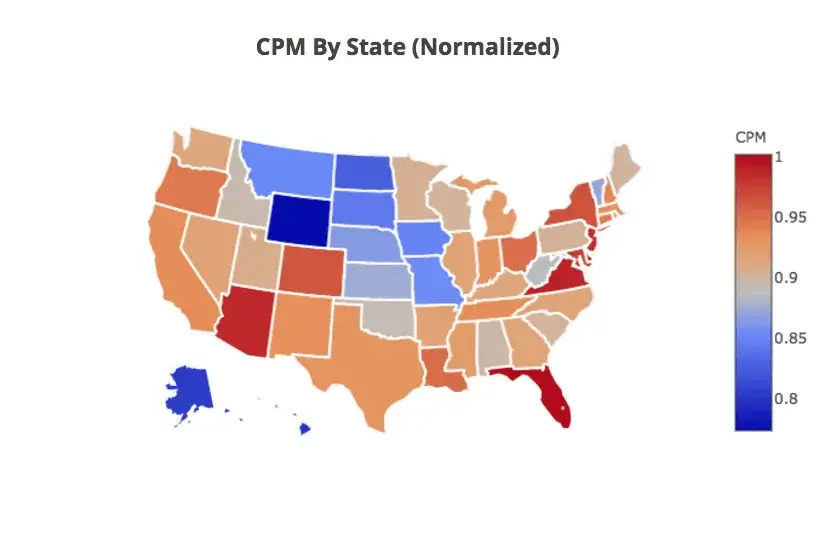How much will advertisers pay for a website visitor?
The quick answer is that the price advertisers pay per visitor varies. With the percentage of money spent on programmatic ad bidding auctions increasing every year, people want to know: “Am I getting paid the right amount for the ads that are showing on my website? Are the people coming to my website the type of traffic that advertisers are paying a lot of money for?”

If you’re hoping to figure out how much will advertisers pay for your content to reach their audience, you’ve come to the right place.
Below, I’m going to answer those questions and more.
Why do advertisers pay different prices for different audiences?
The biggest thing to remember when answering this question is that all the traffic coming to your website is not the same. Most publishers understand this. Bot traffic, in comparison to real traffic, can dilute both website performance and ad revenues.

On the other hand, really great, high-quality traffic from the zip code right outside of Cape Canaveral is extremely valuable (known for having some of the highest ad rates in the world). This zip code is where all the NASA scientists live. Additionally, even states or providences within the same country can see lower ad rates than others. For example, Colorado and Kansas are right next to each other but have very different average CPMs (average price paid by advertiser per 1,000 ad impressions).
So why is there such a big difference?
Well, it’s in the value. Advertisers are trying to find their peak audience, and they’re usually trying to get them to do one of these things:
- Click on the ad so they can create awareness
- Want the visitor to see their ad so they can remember the brand
- Want them to buy something
Advertisers have a defined audience persona that they’re trying to target. Historically, advertisers have been able to learn from certain sites and types of visitor behaviors to help them answer questions like, “When would a visitor be more interested in buying this product than others?”

EXAMPLE: Advertisers may know that their target audience buys more on desktop than on mobile. So, they may be willing to pay a premium for desktop traffic. So, that same visitor may be worth a lot more to advertisers on desktop than they are on mobile.
Advertisers are looking at thousands of variables. There’s the Google Real-Time Bidding Protocol that provides a list of all the different paths that advertisers will look at, typically, programmatically (Adwords, DFP) to target a specific type of person.
What determines the price advertisers pay for impressions on certain visitors?
How advertisers think: Every type of advertiser is going to have a different idea of what their target audience value is. If you’re selling a pair of sandals for $50, then the value of advertising is not going to be all that high, because at maximum, you’re going to have a $50 sale, therefore you probably don’t want to spend more than $50 to advertise that particular product to a single customer. These types of advertisers are naturally going to be in a lower-priced space.

On the opposite side, if your product is a $5000 per month subscription for private jet service, you are selling a luxury item and you will probably spend a lot more to reach a very niche market in order to get those people to buy.
In reality, most sites see a spectrum of all different types of advertisers.
But usually, different audiences will have offshoots in different directions. This is why you see verticals like financial services that have high ad rates within that niche.
Can the price be different for the same person on the same site?
So we already have an idea of what the value is, but the next step in determining what a publisher is actually paid is the bidding auction itself.
The auction takes place on the publisher’s site in real-time, and again, these values are based on historical information. So an advertiser already knows their audience, the visitor lands on their page, and the advertiser can see the historical value of that data.
- What have other advertisers paid in the past?
- How has this type of visitor browsed the site in the past?
- On average, what is the viewability of this ad space?
- Is there a bunch of open ad space on the page?
- Is there a lot of competition for ad space?
- Is there also the possibility of the other ads diverting the attention of the visitor?
These questions will determine if an advertiser bids, how high they bid, and if they elect to bid on multiple spaces or not.

On the other hand, there may only be a small number of ad slots on the page, which will increase demand. What ad price boils down to is how many advertisers are competing for that ad space. Ideally, what you’d want are those high-value advertisers that have a higher threshold of money they’re willing to spend to reach the audience in a very competitive situation on your page.
This means the right balance of total ads on your page and the ability to understand supply and demand is the most effective strategy for your site. The culmination of those two things is what’s going to determine what advertisers pay for certain impressions for certain visitors.
Should I set bid floors for my ads?
Maybe? Unless you’re setting these bid floors at a per person and per visit basis, then it’s actually not possible to say that you’re going to be able to optimize the price for your audience without replicating the process for every single unique auction. You also have to understand thousands of different variables about the visitor’s historical behavioral data and the auction itself.

People are always surprised to learn that if the exact same person comes to the exact same page on the exact same site two separate times, advertisers might pay completely different prices for that same visitor. Bids are never consistent, and the reason for this is that advertisers are going to naturally bid differently.
What happens to ad rates when traffic increases or decreases?
It depends on your audience. People sometimes operate under the assumption of, “If I double my traffic, I will double my revenue.” But whether that is true depends. If you double the exact same traffic you currently have, then yes, it’s very possible to double your revenue.
It’s also possible that when you double your traffic since you now have a larger audience, your ad inventory could become more limited and even more valuable to advertisers. Or the opposite could happen.
Your revenue and traffic are going to have more of a correlation, but it’s not going to be exactly 1:1.
A good example of this exists in one of our case studies. What you’re seeing in the graphic below is a site whose EPMV is consistently increasing as Ezoic’s AI is learning. But then, there’s a hard EPMV drop in March.
What happened?

What we discovered was that the publisher had made their site to that everyone who logged in with a free subscription would be able to see the site ad-free. These ‘logged in’ visitors were the site’s most valuable visitors and were then taken out of the revenue pool.
Overall, this is why the average EPMV dropped suddenly, and the publisher lost more money from that portion of traffic because they were the most valuable. The ad rates didn’t go down, just the people who were responsible for bringing up the ad rates were removed from the pool.
This is why you need to take into account changes that you’ve made on your site that may include or exclude certain types of visitors.
What type of traffic is the most valuable to advertisers?
Engaged traffic is the most valuable traffic to advertisers. Instead of spending the majority of your time trying to figure out if you’re going to create more content about finance, you want to make sure that you’re pushing the content out that’s most valuable to your visitors. What’s most valuable to your visitors will be more valuable to advertisers.
You want to ask yourself questions like:
- What is my most valuable article for visitors?
- Which content has the highest EPMV?
- Which articles have the highest engagement time?

Once you know the answers to those questions, you can start writing more content that mirrors what you’ve already produced that’s proven useful to your visitors.
How do you make a site more valuable to advertisers?
You want to ensure you’re looking at your site holistically. Remember that all the traffic coming to your website is not the same.
These are just a few of the key points in this article, but the most important piece of information to remember is that engaged traffic is the most valuable to advertisers. If you’re wanting to learn more on how to make your site more valuable to advertisers, we’ve written some blogs around this topic:
- How To Make Your Website Ads More Valuable To Advertisers
- Is Digital Content Getting More or Less Valuable?
- The State of Programmatic Revenue in 2019
- What Websites That Tripled Display Ad Revenue Have In Common
- Google AdSense Optimization Tips For Better Revenue & Better UX
If you have any comments or questions, I’ll try to respond to them below.


